My parents periodically had out of state friends visit us, and of course, we always took them to see the sights in Atlanta. In the late 1960s and 70s the sights included the Varsity, a trip to the airport to watch planes take off and land, and we would have been considered poor hosts if we didn’t take guests down to Tenth and Fourteenth Streets to gawk at the hippies.
Apparently, Atlanta has always had certain must-see sights to show out of town guests. I found this quote from former governor John M. Slaton who recalled in the 90s – that would be the 1890s – one always took visitors to see the state capitol building, Lithia Springs, and Baltimore Block.
Well, I can certainly understand the draw of the state capitol especially if they had the two-headed calf on display back then, and since I research and write about Douglas County I can even understand the draw of Lithia Springs in the 1890s regarding the Sweetwater Park Hotel and the Piedmont Chautauqua. If you aren’t familiar with those Lithia Springs locations, you might want to pick up my next book that will be available early in 2016, but Baltimore Block?
What the heck was that?
Look at this grand mansion in the picture I’ve posted below (photo courtesy of the Atlanta History Center).
This is the mansion of Calvin W. Hunnicutt. It’s a view of his home via a side street that at the time was known as Hunnicutt Avenue.
Makes sense, right?
Hunnicutt’s home sat along Spring Street, and he owned various parcels of land including the land along Hunnicutt Avenue.
At the time the area where Hunicutt lived was very fashionable. It was considered the northern end of the city. In fact, Tenth Street was the dropping off point, since anything past Tenth was farmland, and the roads steadily got worse.
In 1885, along came a company by the name of Atlanta Land and Annuity Company owned by a group of businessmen from Baltimore led by Jacob Rosenthal. They bought the land along Hunicutt Avenue for $22,000 and built fourteen townhomes – the first type of apartment homes in Atlanta. Amazingly, eight of the homes still exist!
In the tradition of Baltimore row houses, Rosenthal built homes that appealed to the folks in Atlanta because they were different. Of course, the homes didn’t spread out. They were taller than they were wide rising to a height of three floors. Each home had a depth of seventy feet, one bath, and a kitchen on the basement floor. The homes boasted the first central heating system in Atlanta. Known as a Baltimore heater it was fitted into the fireplace on the first floor with vents running to the upper floors.
Of course, Hunnicutt Avenue soon became known as Baltimore Block, and it became one of THE places to live in Atlanta or at least to be seen. During the late 1800s ladies would have social gatherings called “at homes”, and to be invited to an “at home” on the Baltimore Block meant you had “arrived.” There are also stories of fantastic New Year’s Eve parties on the block as well. Another draw was the street itself. It was cobblestone, and added to the unique look of the block.
There were other draws to the property such as the fantastic recessed doorways.
The Baltimore Block homes were also unique in that it was based on the first long-term lease ever consummated in Atlanta. You could purchase one of the homes for $4,000 and take on the responsibility for the taxes, upkeep, etc., but the interesting part of the deal was owners actually leased the land from the Atlanta Land and Annuity Company.
In his book Atlanta and Environs, Franklin Garrett explains that the “arrangement was quite complicated for those days of straight sales.”
Once the purchaser agreed to pay $4,000 for the home, he then leased the ground occupied by the building for a term of 99 years at the annual rental of $110 each. This brought the company an annual return of $1,540 on its original investment.
Take another look at the picture I posted above of the Hunnicutt mansion. At the time the picture was taken the row houses had already been built. You can make them out a little in the picture, but here is a better one taken in the 1970s when one of the homes was a bar known as Bottom of the Barrel (photo courtesy of the Atlanta History Center).
Unfortunately, by 1908, popularity of the Baltimore Block had waned as the fashionable people moved further north, and for a few years the area declined. Four of the units were torn down in 1924.
By the 1930s, the block was run-down and home to vagrants, but a new crowd began to move in.
Folks like Harvey M. Smith, Jr. moved into 17 Baltimore Place. Known for many things including being a close friend of Margaret Mitchell, Mr. Smith published Southern Architectural Review.
Other notable residents during that time were Mr. and Mrs. William Hunter. They moved to Atlanta from Pennsylvania and bought unit 13. Some of the regulars in the neighborhood weren’t too happy about that. See, they bought the one unit on the block that had a missing front door. Folks had been using the unit as a walk-through from one side of the block to the other. Mr. Hunter was a landscape architect, and Mrs. Hunter collected antiques.
It was the Hunters who were the long hold-outs during a push by Asa G. Candler to purchase the entire block for a medical complex he wanted to build. Since the Hunter’s wouldn’t sell, the deal fell through. Mr. Candler had to go elsewhere for his building which happened to be Crawford Long Hospital.
Another notable to the Baltimore Block re-birth was Nancy Barrington Dolinoff de Welles, sometimes referred to as the Countess. She was born in Mobile, Alabama, but if you are familiar with Roswell she was one of the Barringtons of Barrington Hall. The Countess was in Paris at the beginning of World War II. She fled to the United States shipping everything in sections. She took over units 15, 17 and 19 along the block making a very nice home for her and her two daughters.
By the 1960s another change came to Baltimore Block as the row houses became home to Atlanta’s Beat Generation – a center of counterculture.
At one point a developer came in and wanted to redevelop the block, but again one lone holdout kept the project from happening Property owner Isobel Hunter Quentin put her foot down and wouldn’t sell.
You guessed it! She was the daughter of the Hunters who some years before wouldn’t see to their unit to Asa G. Candler.
…and it’s a good thing. I’m glad she waited for E.R. Howington Associates to come along. In the late 1980s they bought the block and renovated it into office space. The block is now joined by a glass-roofed atrium to an addition in the back featuring a high rise with more office space and several penthouse apartments.
Today Baltimore Block is part of Atlanta’s SoNo District.
SoNo?
Yes, the area of town south of North Avenue – a name the area has held since 2005 when folks decided they wanted a trendy name, but you know what?
I don’t think SoNo makes the area trendy. I think it has something to do with the history of the area. The ebb and flow of a block where many different people lived for over a hundred years.
The history of Baltimore Block is the draw, and I’m awfully glad it’s still around even if it is a different form from the original.
Here’s one last image – a photo taken in 1895. The subject of the photo happened to be a few convicts and their guard, but look in the background. Yes, that’s Baltimore Block behind them soon after it was built (photo courtesy of Vanishing Georgia, Georgia Archives, Morrow, Georgia).
As always thanks for visiting. You can view my latest book, Georgia on My Mind: True Tales from Around the State by clicking on the highlight title. The book includes 30 true tales from around the state including three stories from Atlanta!

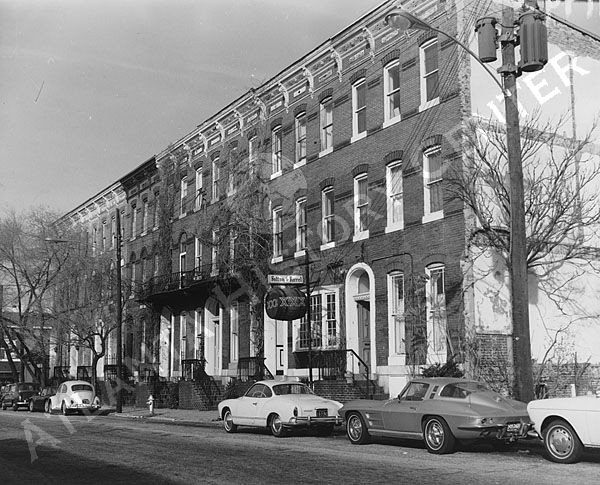
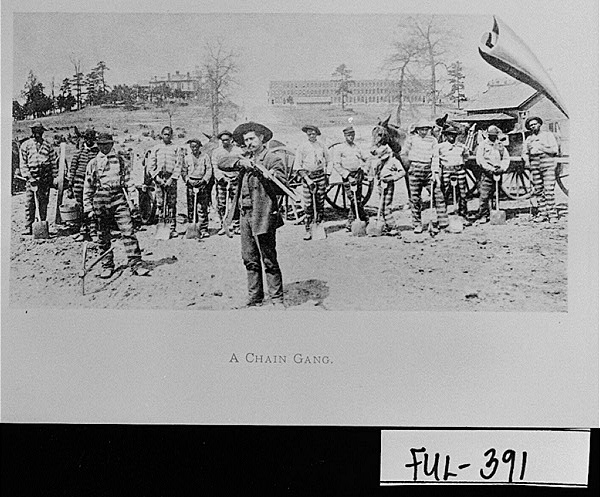
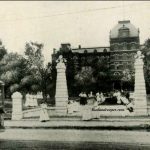
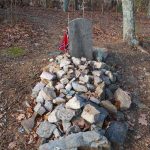

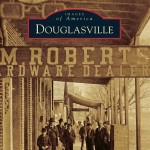
My husband lived on Baltimore Block for about two years as a student at Ga Tech in the late 50’s. It was a very interesting place! His housemate lived there for a longer period of time and even met and married his first wife while living there. We visited a few times in the early 60’s and I was quite fascinated by the Block and atmosphere. It was an amazing place and I’m so glad I found your piece. My husband’s dementia is quite bad, but he really enjoyed this and the accompanying photos and recalled some of the times he had on Baltimore Block. Thank you, Lisa, for making our day so enjoyable.